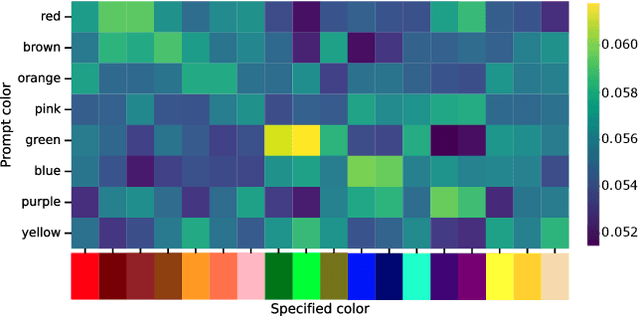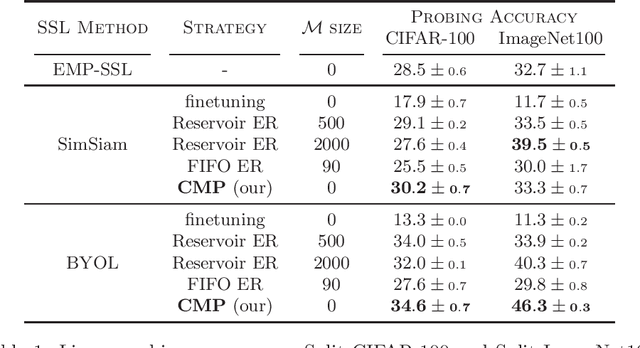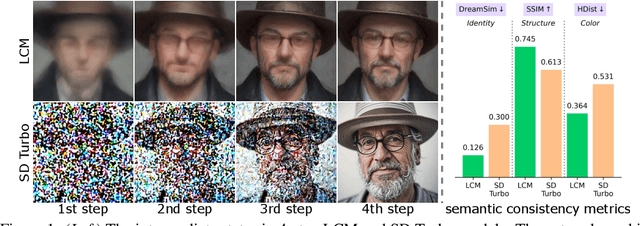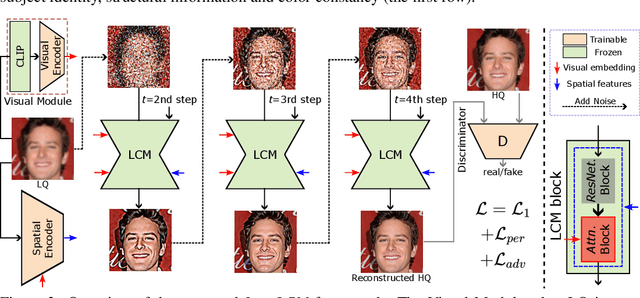Joost van de Weijer
Continual Learning for VLMs: A Survey and Taxonomy Beyond Forgetting
Aug 06, 2025Abstract:Vision-language models (VLMs) have achieved impressive performance across diverse multimodal tasks by leveraging large-scale pre-training. However, enabling them to learn continually from non-stationary data remains a major challenge, as their cross-modal alignment and generalization capabilities are particularly vulnerable to catastrophic forgetting. Unlike traditional unimodal continual learning (CL), VLMs face unique challenges such as cross-modal feature drift, parameter interference due to shared architectures, and zero-shot capability erosion. This survey offers the first focused and systematic review of continual learning for VLMs (VLM-CL). We begin by identifying the three core failure modes that degrade performance in VLM-CL. Based on these, we propose a challenge-driven taxonomy that maps solutions to their target problems: (1) \textit{Multi-Modal Replay Strategies} address cross-modal drift through explicit or implicit memory mechanisms; (2) \textit{Cross-Modal Regularization} preserves modality alignment during updates; and (3) \textit{Parameter-Efficient Adaptation} mitigates parameter interference with modular or low-rank updates. We further analyze current evaluation protocols, datasets, and metrics, highlighting the need for better benchmarks that capture VLM-specific forgetting and compositional generalization. Finally, we outline open problems and future directions, including continual pre-training and compositional zero-shot learning. This survey aims to serve as a comprehensive and diagnostic reference for researchers developing lifelong vision-language systems. All resources are available at: https://github.com/YuyangSunshine/Awesome-Continual-learning-of-Vision-Language-Models.
One-Way Ticket:Time-Independent Unified Encoder for Distilling Text-to-Image Diffusion Models
May 28, 2025Abstract:Text-to-Image (T2I) diffusion models have made remarkable advancements in generative modeling; however, they face a trade-off between inference speed and image quality, posing challenges for efficient deployment. Existing distilled T2I models can generate high-fidelity images with fewer sampling steps, but often struggle with diversity and quality, especially in one-step models. From our analysis, we observe redundant computations in the UNet encoders. Our findings suggest that, for T2I diffusion models, decoders are more adept at capturing richer and more explicit semantic information, while encoders can be effectively shared across decoders from diverse time steps. Based on these observations, we introduce the first Time-independent Unified Encoder TiUE for the student model UNet architecture, which is a loop-free image generation approach for distilling T2I diffusion models. Using a one-pass scheme, TiUE shares encoder features across multiple decoder time steps, enabling parallel sampling and significantly reducing inference time complexity. In addition, we incorporate a KL divergence term to regularize noise prediction, which enhances the perceptual realism and diversity of the generated images. Experimental results demonstrate that TiUE outperforms state-of-the-art methods, including LCM, SD-Turbo, and SwiftBrushv2, producing more diverse and realistic results while maintaining the computational efficiency.
Free-Lunch Color-Texture Disentanglement for Stylized Image Generation
Mar 21, 2025



Abstract:Recent advances in Text-to-Image (T2I) diffusion models have transformed image generation, enabling significant progress in stylized generation using only a few style reference images. However, current diffusion-based methods struggle with fine-grained style customization due to challenges in controlling multiple style attributes, such as color and texture. This paper introduces the first tuning-free approach to achieve free-lunch color-texture disentanglement in stylized T2I generation, addressing the need for independently controlled style elements for the Disentangled Stylized Image Generation (DisIG) problem. Our approach leverages the Image-Prompt Additivity property in the CLIP image embedding space to develop techniques for separating and extracting Color-Texture Embeddings (CTE) from individual color and texture reference images. To ensure that the color palette of the generated image aligns closely with the color reference, we apply a whitening and coloring transformation to enhance color consistency. Additionally, to prevent texture loss due to the signal-leak bias inherent in diffusion training, we introduce a noise term that preserves textural fidelity during the Regularized Whitening and Coloring Transformation (RegWCT). Through these methods, our Style Attributes Disentanglement approach (SADis) delivers a more precise and customizable solution for stylized image generation. Experiments on images from the WikiArt and StyleDrop datasets demonstrate that, both qualitatively and quantitatively, SADis surpasses state-of-the-art stylization methods in the DisIG task.Code will be released at https://deepffff.github.io/sadis.github.io/.
EFC++: Elastic Feature Consolidation with Prototype Re-balancing for Cold Start Exemplar-free Incremental Learning
Mar 13, 2025Abstract:Exemplar-Free Class Incremental Learning (EFCIL) aims to learn from a sequence of tasks without having access to previous task data. In this paper, we consider the challenging Cold Start scenario in which insufficient data is available in the first task to learn a high-quality backbone. This is especially challenging for EFCIL since it requires high plasticity, resulting in feature drift which is difficult to compensate for in the exemplar-free setting. To address this problem, we propose an effective approach to consolidate feature representations by regularizing drift in directions highly relevant to previous tasks and employs prototypes to reduce task-recency bias. Our approach, which we call Elastic Feature Consolidation++ (EFC++) exploits a tractable second-order approximation of feature drift based on a proposed Empirical Feature Matrix (EFM). The EFM induces a pseudo-metric in feature space which we use to regularize feature drift in important directions and to update Gaussian prototypes. In addition, we introduce a post-training prototype re-balancing phase that updates classifiers to compensate for feature drift. Experimental results on CIFAR-100, Tiny-ImageNet, ImageNet-Subset, ImageNet-1K and DomainNet demonstrate that EFC++ is better able to learn new tasks by maintaining model plasticity and significantly outperform the state-of-the-art.
Leveraging Semantic Attribute Binding for Free-Lunch Color Control in Diffusion Models
Mar 12, 2025



Abstract:Recent advances in text-to-image (T2I) diffusion models have enabled remarkable control over various attributes, yet precise color specification remains a fundamental challenge. Existing approaches, such as ColorPeel, rely on model personalization, requiring additional optimization and limiting flexibility in specifying arbitrary colors. In this work, we introduce ColorWave, a novel training-free approach that achieves exact RGB-level color control in diffusion models without fine-tuning. By systematically analyzing the cross-attention mechanisms within IP-Adapter, we uncover an implicit binding between textual color descriptors and reference image features. Leveraging this insight, our method rewires these bindings to enforce precise color attribution while preserving the generative capabilities of pretrained models. Our approach maintains generation quality and diversity, outperforming prior methods in accuracy and applicability across diverse object categories. Through extensive evaluations, we demonstrate that ColorWave establishes a new paradigm for structured, color-consistent diffusion-based image synthesis.
Replay-free Online Continual Learning with Self-Supervised MultiPatches
Feb 13, 2025

Abstract:Online Continual Learning (OCL) methods train a model on a non-stationary data stream where only a few examples are available at a time, often leveraging replay strategies. However, usage of replay is sometimes forbidden, especially in applications with strict privacy regulations. Therefore, we propose Continual MultiPatches (CMP), an effective plug-in for existing OCL self-supervised learning strategies that avoids the use of replay samples. CMP generates multiple patches from a single example and projects them into a shared feature space, where patches coming from the same example are pushed together without collapsing into a single point. CMP surpasses replay and other SSL-based strategies on OCL streams, challenging the role of replay as a go-to solution for self-supervised OCL.
No Task Left Behind: Isotropic Model Merging with Common and Task-Specific Subspaces
Feb 07, 2025Abstract:Model merging integrates the weights of multiple task-specific models into a single multi-task model. Despite recent interest in the problem, a significant performance gap between the combined and single-task models remains. In this paper, we investigate the key characteristics of task matrices -- weight update matrices applied to a pre-trained model -- that enable effective merging. We show that alignment between singular components of task-specific and merged matrices strongly correlates with performance improvement over the pre-trained model. Based on this, we propose an isotropic merging framework that flattens the singular value spectrum of task matrices, enhances alignment, and reduces the performance gap. Additionally, we incorporate both common and task-specific subspaces to further improve alignment and performance. Our proposed approach achieves state-of-the-art performance across multiple scenarios, including various sets of tasks and model scales. This work advances the understanding of model merging dynamics, offering an effective methodology to merge models without requiring additional training. Code is available at https://github.com/danielm1405/iso-merging .
No Images, No Problem: Retaining Knowledge in Continual VQA with Questions-Only Memory
Feb 06, 2025Abstract:Continual Learning in Visual Question Answering (VQACL) requires models to learn new visual-linguistic tasks (plasticity) while retaining knowledge from previous tasks (stability). The multimodal nature of VQACL presents unique challenges, requiring models to balance stability across visual and textual domains while maintaining plasticity to adapt to novel objects and reasoning tasks. Existing methods, predominantly designed for unimodal tasks, often struggle to balance these demands effectively. In this work, we introduce QUestion-only replay with Attention Distillation (QUAD), a novel approach for VQACL that leverages only past task questions for regularisation, eliminating the need to store visual data and addressing both memory and privacy concerns. QUAD achieves stability by introducing a question-only replay mechanism that selectively uses questions from previous tasks to prevent overfitting to the current task's answer space, thereby mitigating the out-of-answer-set problem. Complementing this, we propose attention consistency distillation, which uniquely enforces both intra-modal and inter-modal attention consistency across tasks, preserving essential visual-linguistic associations. Extensive experiments on VQAv2 and NExT-QA demonstrate that QUAD significantly outperforms state-of-the-art methods, achieving robust performance in continual VQA.
InterLCM: Low-Quality Images as Intermediate States of Latent Consistency Models for Effective Blind Face Restoration
Feb 04, 2025



Abstract:Diffusion priors have been used for blind face restoration (BFR) by fine-tuning diffusion models (DMs) on restoration datasets to recover low-quality images. However, the naive application of DMs presents several key limitations. (i) The diffusion prior has inferior semantic consistency (e.g., ID, structure and color.), increasing the difficulty of optimizing the BFR model; (ii) reliance on hundreds of denoising iterations, preventing the effective cooperation with perceptual losses, which is crucial for faithful restoration. Observing that the latent consistency model (LCM) learns consistency noise-to-data mappings on the ODE-trajectory and therefore shows more semantic consistency in the subject identity, structural information and color preservation, we propose InterLCM to leverage the LCM for its superior semantic consistency and efficiency to counter the above issues. Treating low-quality images as the intermediate state of LCM, InterLCM achieves a balance between fidelity and quality by starting from earlier LCM steps. LCM also allows the integration of perceptual loss during training, leading to improved restoration quality, particularly in real-world scenarios. To mitigate structural and semantic uncertainties, InterLCM incorporates a Visual Module to extract visual features and a Spatial Encoder to capture spatial details, enhancing the fidelity of restored images. Extensive experiments demonstrate that InterLCM outperforms existing approaches in both synthetic and real-world datasets while also achieving faster inference speed.
Covariances for Free: Exploiting Mean Distributions for Federated Learning with Pre-Trained Models
Dec 18, 2024



Abstract:Using pre-trained models has been found to reduce the effect of data heterogeneity and speed up federated learning algorithms. Recent works have investigated the use of first-order statistics and second-order statistics to aggregate local client data distributions at the server and achieve very high performance without any training. In this work we propose a training-free method based on an unbiased estimator of class covariance matrices. Our method, which only uses first-order statistics in the form of class means communicated by clients to the server, incurs only a fraction of the communication costs required by methods based on communicating second-order statistics. We show how these estimated class covariances can be used to initialize a linear classifier, thus exploiting the covariances without actually sharing them. When compared to state-of-the-art methods which also share only class means, our approach improves performance in the range of 4-26\% with exactly the same communication cost. Moreover, our method achieves performance competitive or superior to sharing second-order statistics with dramatically less communication overhead. Finally, using our method to initialize classifiers and then performing federated fine-tuning yields better and faster convergence. Code is available at https://github.com/dipamgoswami/FedCOF.
 Add to Chrome
Add to Chrome Add to Firefox
Add to Firefox Add to Edge
Add to Edge